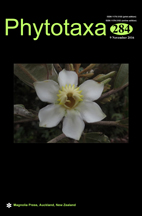Abstract
The genus Trapella Oliver in Hooker (1887: pl. 1595) with one living species Trapella sinensis Oliver in Hooker (1887: pl. 1595) is endemic to the eastern Asia, including China (Anhui, Fujian, Guangxi, Hebei, Heilongjiang, Hubei, Hunan, Jiangsu, Jiangxi, Jilin, Liaoning), Japan (Honshu, Shikoku, Kyushu), Republic of Korea (South Korea) and Russian Federation (Russia Far East, Ussuri) as aquatic perennial herbs in ponds and lakes up to an elevation of 300 m (Wu & Raven 1998, Manchester et al. 2009). A second extant species T. antennifera (Léveillé 1899: 229) Glück (1939: 149) and a variety T. sinensis var. antennifera (Léveillé) Hara (1941: 380) are now regarded to be synonyms of Trapella sinensis (Hassler 2016). Trapella was assigned to the Trapellaceae or Pedaliaceae but recently Gormley et al. (2015) placed the isolated genus in the tribe Gratioleae of Plantaginaceae.

